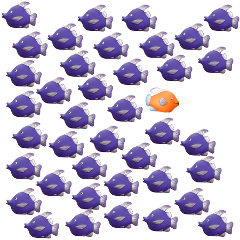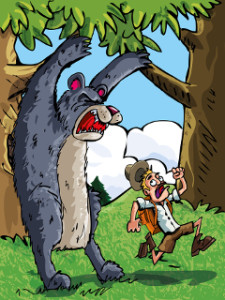Inspiring Story of How A #SmallBiz With Thousands of Competitors Found A Way To Stand Out Using #SocialMedia
 Have you heard the joke that goes:
Have you heard the joke that goes:
Q: How fast do you have to be to outrun a bear?
A: Just a little faster than your hiking buddy.
It’s not the funniest joke we’ve told in this space (or maybe, sadly, it is…) but it does serve to highlight an important point – standing apart is key to survival. But it’s not just key to surviving a race with a bear, it’s also critical for small businesses in a crowded space. Businesses that find a way to use social media to stand out in their jam-packed market are the ones that succeed.
So, how can a new business succeed?
OptimalRun.com is a running supply website that has not only survived, but thrived, using social media and video to provide world-class expertise and customer support. We interviewed Patton Gleason, the company’s founder, to find out how Optimal Run stands out from the crowd.
GLEN: Hello Patton, can you tell us how Optimal Run is different from other runner’s supply stores?
PATTON GLEASON: Well, I had been working for a chain of runner’s supply stores, but they were mostly focused on the brick and mortar side. I noticed that there was a real opportunity in e-commerce that wasn’t being met. I’m not talking about just having products online and shipping them quickly – there’s plenty of people like that. What was missing was the customer service piece. I’ll be the first to tell you, I’m not a good sales person. On the other hand, I am a problem solver.
Delivering expertise and helping people find the right solution to their problems, through an e-commerce format, is the foundation we built Optimal Run on.
GLEN: Interesting, and so you used social to provide that expertise?
PATTON GLEASON: Absolutely. We started with blog articles, but specifically chose not to write about the products we sold (Rignite tip: We recommend practicing the 80/20 rule. That is, provide educational, exciting content 80% of the time and promote your brand/products 20% of the time) Instead, we’d write about running tips or share running stories. Soon enough, people started reaching out to us and asking questions. Purely in an effort to save time, we started using video in order to be able to better communicate with customers.
Once we started focusing on video, we tried to refine that system and make it more efficient. When we would get a question on Twitter or on Facebook, we could write a rather long post or, instead, we could shoot a 2 minute video of me or one of our staff explaining the answer.
We looked at social not so much as a media platform, but as if it was the world’s biggest (virtual) retail store. Anybody could walk by and ask a question and as long as we put really good information out and we were authentic about it, people would feel comfortable asking their questions.
GLEN: So is that your content strategy, put out good content and wait for people to ask questions?
PATTON GLEASON: Well, yes, but it’s more than that. I think the worst thing to happen to social media is that people use the word “media.” Because then everybody thinks like a media tycoon and tries to create a great ad. We think of it as a relationship or communication channel, and for us, that’s made all the difference.
We do, of course, publish some product information and promote a sale or deal from time to time, but mostly we’re using our social media management software to listen to what people are asking. We’ll use that to proactively answer questions on our blog or through video.
A key word in just about everything we do is “empower.” If we can give somebody the best information, the best resources and the best tools, they can take that and write their own story and they can really be in control of their own destiny.
GLEN: Has your focus on empowerment and individuals led to any noteworthy successes?
PATTON GLEASON: One early example does come to mind. In watching our Twitter feed, we noticed a woman mention that her knees hurt when she ran. We reached out to her and asked her to record a video of herself running and send it to us. Once we got the video, we were able to see the problem and recommend a pair of shoes to correct her stride. It was such a big success that we created the Personalized Footwear Recommendation program and now use video to make better shoe and equipment recommendations on a regular basis.
GLEN: That is an awesome story… but now comes the flipside of the coin. Have you ever tried something that didn’t work?
PATTON GLEASON: Yes, heavily promoting sales. It seems that that’s the easiest way to have people start tuning out of your news feed and twitter stream. When we were a young company I thought that’s what everybody in ecommerce does—discount the brick and mortar stores and try to compete really well on price. That was just not effective for us at all. If I go back and look at our Facebook and Twitter history, you can definitely see patterns of engagement. When we did things that were really high in promoting sales and really pumped that up, there is always a falloff.
GLEN: That’s a good lesson for companies to learn – good content and communication can be more important than having the lowest prices or coolest sales. How has all of this social activity helped your business?
PATTON GLEASON: I’m not kidding when I say that it’s been 80% responsible for our success. That’s a gut-feel number, but I strongly believe it. The cool thing about social media is that it levels the playing field for everyone.
Social Media presents this beautiful double-edged sword because if you cultivate communities and have a unique value proposition, people can’t wait to talk about you. If you create systems to promote and enable that conversation, the sky is the limit for what somebody can do.
It is also a total double-edged sword because if you do a half-assed job or you slipped up a little bit, people can’t wait to rip you up and down. You are instantly accessible. There is no more hiding. I tend to think that’s a good thing because it forces you to pay careful attention to social media, but it’s definitely a double-edged sword.
GLEN: Thank you so much for sharing your story with us Patton, it’s a great example of how to use social media to stand out. Before you go, do you have any last words of wisdom to pass on?
PATTON: Definitely.
Treat social like you treat your direct customer service line. As businesses moved to e-commerce, personal interaction was often the first thing sacrificed. Nowadays, people crave that again, they want people to give a &%#! about them and their outcome.
But, they still want it with the convenience of at-home shopping. That’s where social media comes in. If you utilize it as a communication tool and a place to learn the stories of people, social media is really, really, really valuable.
GLEN: Spot on, Patton. Spot. On.
 And before we go, we’d like to leave you with these words of wisdom: Bears can run as fast as 35 miles an hour. Patton told us offline that he doesn’t have any shoes that can make you run that fast, so if you’re being chased by a bear… well, maybe just don’t get chased by a bear.
And before we go, we’d like to leave you with these words of wisdom: Bears can run as fast as 35 miles an hour. Patton told us offline that he doesn’t have any shoes that can make you run that fast, so if you’re being chased by a bear… well, maybe just don’t get chased by a bear.
Tell us…what are some ways you’ve outrun the big dogs by using social media? Or share good examples you’ve seen in the wild.
